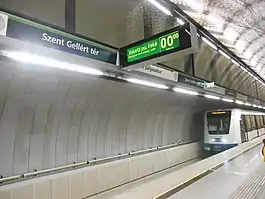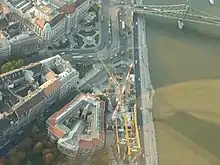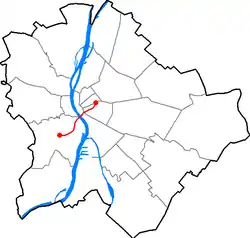Metro Line M4 (Budapest Metro)
Line 4 (officially: South Buda–Rákospalota (DBR) Line, Metro 4 or M4, and unofficially: Green Line) is the fourth line of the Budapest Metro. It opened on 28 March 2014.[3]
| Metro Line M4 | |||
|---|---|---|---|
 | |||
 A train arrives at Szent Gellért tér. | |||
| Overview | |||
| Status | Operational | ||
| Line number | Line 4 ("Green metro") | ||
| Termini | Kelenföld vasútállomás Keleti pályaudvar | ||
| Stations | 10 | ||
| Website | www.metro4.hu | ||
| Service | |||
| Type | Rapid transit | ||
| System | Budapest Metro | ||
| Operator(s) | BKV | ||
| History | |||
| Opened | March 28, 2014 | ||
| Technical | |||
| Line length | 7.4 km[1] Phase II (planned): 3.2 km | ||
| Track gauge | 1,435 mm (4 ft 8 1⁄2 in) | ||
| Electrification | 750 V DC | ||
| Operating speed | 80 km/h[2] | ||
| |||
The first section, 7.4 km in length and consisting of ten stations, connects the southwestern Kelenföld vasútállomás located in Buda, and the eastern Keleti pályaudvar in Pest, under the River Danube. While three additional sections — one an eastern extension to Bosnyák tér, the second west to Virágpiac, and a third further east to Újpalota — have been planned, these remain unfunded by the Budapest city government and the European Union.[4]
Before Line 4 was built, only Line 2 served the Buda side of the river. Daily ridership has been estimated at 421,000. The line operates using fully automated Alstom Metropolis train sets, which are also used on Line 2.[5]
In Hungary the construction of the line has been widely criticised because its route was perceived as outdated, although the general city-structure and population density remained unchanged. The line has been noted for its high costs and inordinate delays — 17 in total — during construction.[6][7]
History
The first plans for a fourth metro line were developed in 1972; the line was planned to run between South Buda and Rákospalota/Újpalota, later to Zugló.[8] The first decree was made in 1976 and the government wanted to start construction in 1978, however the project was suspended in 1978, in favour of extending Line 3.[8]
Construction eventually started in 2004, and the first section with 10 stations opened in 2014.
M4 has a transfer station for Line 2 at Keleti pályaudvar and for Line 3 at Kálvin tér station.
| Sections[1][9] | Opened | Length | Stations |
|---|---|---|---|
| Kelenföld vasútállomás - Keleti pályaudvar | 28 March 2014 | 7.4 km (5 mi) | 10 |
| Keleti pályaudvar - Bosnyák tér | planned | 3.2 km (2 mi) | 4 |
| Kelenföld vasútállomás - Madárhegy | planned | 2.1 km (1 mi) | 2 |
| Total | planned | 12.7 km (8 mi) | 16 |
Controversies

The construction of the line has been widely criticized as slow and incompetent. Critics have panned the constant delays as evidence of widespread government corruption.[10]
Delays
The Budapest city government delayed the opening of the line 17 times. Gábor Demszky, the liberal mayor of Budapest from 1990 to 2010, originally promised in 1998 that the first section of the line would be open by 2003. However, Viktor Orbán's first government (1998-2002) withheld funds necessary for starting the construction. The project restarted in 2003 under the socialist-liberal national government. In 2004, as construction still hadn't begun, Demszky amended the opening date to 2008. The construction works finally started in 2006; in that year the scheduled opening was changed to 2009. It was again changed - in April 2007 - to 2010; and in October 2007 to 2011.[6]
In 2008, Gusztáv Klados, the line's project manager, announced that the opening would be further delayed until the end of 2011.[11] In 2009, he stated the opening would be delayed until 2012.[12] Later that year, Klados further delayed the opening until 2012,[13] and one year later, in 2010, István Tarlós, Demszky's Fidesz successor as mayor, pushed the likely opening back to as late as 2015.[14]
In 2011, deputy mayor Gyula Hutiray reaffirmed the 2015 completion date.[15] Tarlós later clarified that a 2013 or 2014 opening were not outside the realm of possibility.[16][17]
The line was opened by Prime Minister Viktor Orbán on March 28, 2014, one week before the parliamentary elections that saw his party, Fidesz, reelected to a second supermajority. Orbán made several references to his government's extensive infrastructure projects during the ceremony. Unlike the transport facilities that were the infrastructure projects of the socialists, the projects started by Orbán's government were mainly cultural facilities.[18]
Costs
Construction of the line cost 1.5 billion Euros, or 1.5% of Hungary's annual GDP, of which 600 million came from European Union funds.[18] According to estimates the first section of the M4 will have cost approximately 452 billion HUF to build alongside an annual operating cost of 6 billion HUF, which is fourfold the operating costs of the M2 and M3 combined. These funds, critics claim, would have been better invested in other large-scale transportation projects such as the connection of M2 to the Gödöllő HÉV or the construction of new tram lines.[7] Rumors that the M4 would be the most expensive metro line ever built, however, have been rebuffed by contractors.[19]
Route
Critics have noted that the route served by Line 4 was already extensively served by a variety of tram (19, 47, 49) and bus (7, 7A, 7E, 173E) lines. The line has also been criticized for densely placed stations, some, such as Móricz Zsigmond körtér and Újbuda-központ, within a few hundred meters of one another.[7] On the other hand, the city government has conducted research showing that the new line will reduce travel times on a heavily used transit corridor, because travel in the subway is not slowed by the traffic jams on the surface.[20]
Unfunded extensions
Despite long-term plans, which included the eventual extension to Rákospalota, future extensions to the M4 are uncertain. Tarlós's Fidesz city government eliminated funding for the second phase of the line after taking over from Demszky's government, and the European Union has refused to provide additional funds.[4] Some critics claim that without the extensions the current state of the line amounts to "several hundred-million forints thrown out the window."[4]
Operation
Driverless trains have been in operation since the opening,[21] but until January 2016 all trains ran with on-board driver supervision. Since January 2016 the driver cabs have been removed and there is no on-board supervision.
Stations and connections
| Travel Time min:sec |
Station | Travel Time min:sec |
Connection | Buildings / Monuments |
|---|---|---|---|---|
| 0:00 | Kelenföld vasútállomás ♿ | 13:45 | Hungarian State Railways (MÁV) | Kelenföld railway station, Intermodal junction |
| 1:42 | Bikás park ♿ | 12:15 | Market | |
| 3:52 | Újbuda-központ ♿ | 10:07 | Allee, Market Hall | |
| 5:10 | Móricz Zsigmond körtér ♿ | 8:45 | Major public transport hub, Lake Feneketlen | |
| 6:52 | Szent Gellért tér – Műegyetem ♿ | 7:05 | Budapest University of Technology and Economics, Gellért Thermal Baths and Swimming Pool | |
| 8:07 | Fővám tér ♿ | 5:55 | Corvinus University of Budapest, Great Market Hall | |
| 9:30 | Kálvin tér ♿ | 4:35 | Hungarian National Museum, Fővárosi Szabó Ervin Könyvtár | |
| 11:12 | Rákóczi tér ♿ | 2:47 | Market Hall | |
| 12:35 | II. János Pál pápa tér ♿ | 1:22 | Erkel Theatre | |
| 13:45 | Keleti pályaudvar ♿ | 0:00 | Hungarian State Railways (MÁV) | Budapest Keleti railway station, Aréna Plaza |
External links
References
- Budapest Metro Line 4, main data
- Siemens.com Budapest Line 4 Archived 2012-12-18 at Archive.today
- "Orbán: Hihetetlen, de elkészült". origo.hu. 28 March 2014. Retrieved 2014-03-28.
- Király, Dávid. "4-es metró: örülünk, de ez még nincs kész". bkvfigyelo.blog.hu. BKV Figyelő. Retrieved 8 July 2014.
- ALSTOM Alstom delivers the first Metropolis for the Budapest Metro in Hungary 11 February 2009
- Meghúzzák és eltolják a 4-es metrót – Népszabadság, 2007. október 26.
- (Mandiner, 17 January 2014)
- László Pintér - Tamás Várady: A 4-es (DB-Belváros-Zugló) metróvonal megépítésének indoklása, műszaki kialakításának lehetőségei, Városi Közlekedés, Year XXXI, Vol. 2, pp. 69-70, Budapest, 1991
- Budapest Metro Line 4, stations
- budapesttimes.hu Light at end of M4 tunnel: Mayor 25 April 2012
- Két hét múlva újra fúrhatják a metrót – Index, 2008. november 5.
- Csak 2012-ben indulhat a 4-es metró próbaüzeme – Index, 2009. április 9.
- Tovább késik a 4-es metró átadása – Index, 2009. október 15.
- Tarlós: 2015-re készülhet el a metró – 2010. október 13.
- 2015-től vihet utasokat a 4-es metró (Index, 2011. május 25.)
- 2014 elejéig átadják a 4-es metró első szakaszát - lapszemle (Inforádió, 2011. augusztus 26.)
- Kihaltak a 4-es metró fenti munkaterületei (Index, 2011. október 21.)
- Feher, Margit. "Budapest Opens 4th Subway Line". The Wall Street Journal. Retrieved 8 July 2014.
- (HVG, 3 December 2009)
- (BKK, June 2010)
- Railway Gazette International May 2014, pg 15.
| Wikimedia Commons has media related to Budapest Metro line 4. |

